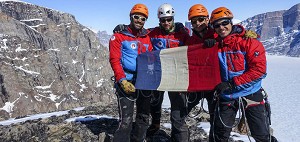
Skiing Baffin’s couloirs has been on my to do list ever since I saw Andrew McLean and Brad Barlage’s inspirational trip report from there. The place is filled with aesthetic splitter couloirs between the biggest walls on the planet in a remote area within the Arctic Circle. With guaranteed cold snow and the ability to ski around the clock in 24 hour daylight, what’s not to like.
Our trip started out in mid-April at Clyde River by securing a skidoo ride from the Inuit hunters to the Fjords. Ilko and his son John agreed to take myself, Michelle and Marcus out to Scott Island on a Komatik (wooden sled). Ilko was a man from a bygone era for us Westerners and had lived in a tiny remote settlement to the North of Clyde River until he was 26 years old, surviving by hunting. He displayed the calm confidence of a man who knew how to take care of himself in the wilderness.
The ride out was brutal with the wooden komatik slamming every few seconds as it hit wave after wave of wind hardened sastrugi. The roughness of the ride also took its toll on my body as each blow would rattle right up your spine and I eventually adopted the crouching position on hands and knees with arms slightly bent to absorb the shock. The following day we would all had crippling headaches from back and neck spasms.
As we headed North across the mouth of Sam Ford Fjord we found a seal pup that had been killed at a breathing hole. The polar bear had only taken a bite and left the remainder of the kill showing that food was currently plentiful. Nothing goes to waste in the Arctic and our Inuit guides quickly bagged the dead seal for their dinner.
As we progressed inland past the 600m high Ship’s Prow and 71 degrees North point into Scott Inlet, we caught glimpse of some stunning ski lines and since we were over the komatik ride, we asked Ilko to stop. It was getting late and with the temperature dropping we raced to get the stoves going, eat some food and make camp. After months of emails, calls, procurement, logistics and planning, it felt pretty awesome to finally be in the place we had all been dreaming of. Looking around at this ski mountaineer’s playground that we had to ourselves put a smile on my face. Ilko and John took off with a wave and gunned the skidoos out of site. It would be a longer day for them. Our final task before bed was to get the bear perimeter operational. Poles supported a perimeter rope attached to a pin trigger on a refillable air horn. We hoped the fence would put our mind at rest and allow us to get some sleep, albeit with a gun at hand either side of the tent.
On the first morning there was wind down fjord and I had to learn about kiting very quickly before the other two more experienced kiters left me behind. Over the next 3 days we skied 5 lines on Scott Island, 3 of which were outstandingly beautiful, varying in length from 450 to 620m vertical. Asides from the skiing I have some great memories from hanging out on the summit plateau enjoying the evening light and the relative warmth far above the sea ice with views stretching from Gibbs Fjord out into Baffin Bay.
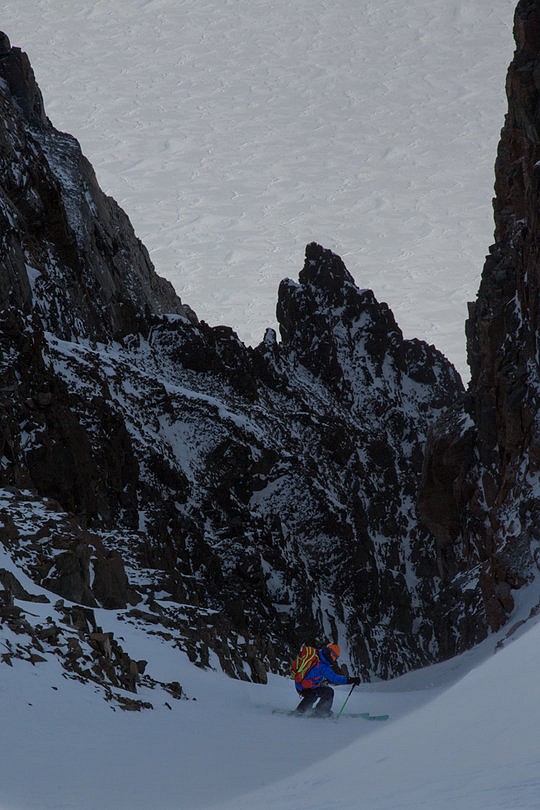
It was soon time to move camp and as luck would have it the wind was blowing inland so we caught a ride 35km into Gibbs Fjord to our second base camp. Well, Michelle and Marcus managed 35km but with a smaller kite I got becalmed after 30km and had been working hard all day to fly it in the light winds. I had been flying continuously for six hours by now and being a novice kiter I was pretty spent. I wasn’t able to fly, ski, watch the loads on my 2 sleds and eat & drink all at the same time. After an hour untangling lines, righting the kite, and trying to re-launch without luck my toes were getting dangerously cold as the boot liners froze. While I ate and rehydrated I got into my sleeping bag to rewarm my feet and thaw my boot liners out. It was a fine night to bivi and in the morning there could be wind to use to re-join the others. At worst it would be sled hauling in the sun rather than in the damp polar frost that was descending fast. The radio batteries weren’t working in the cold so I went to sleep with the gun at my side and some extra rounds at hand. I must have been asleep an hour when Michelle woke me up. She had skinned back with a thermos of hot water and food, a little worried and unsure as to why I had stopped. After my short nap I felt a lot better, and we skinned the last 5 km up fjord together.
Camped in the middle of the Gibbs Fjord, we all became ‘fools of scale’ to quote Jordan Manley. The following day we set off on a south facing line on Sillem Island that looked about 700 m high. After 500 m we reckoned 350 m remained. After another 300 m it looked like it was about 150m to the top. We finally topped out at 1300 m! The view from the top was breath taking with a 360 degree panorama of fiords, glaciers, towering big walls and islands. Down below gorgeous red minarets lined the sides of our couloir, reminiscent of the Y couloir on Aiguille Argentiere.
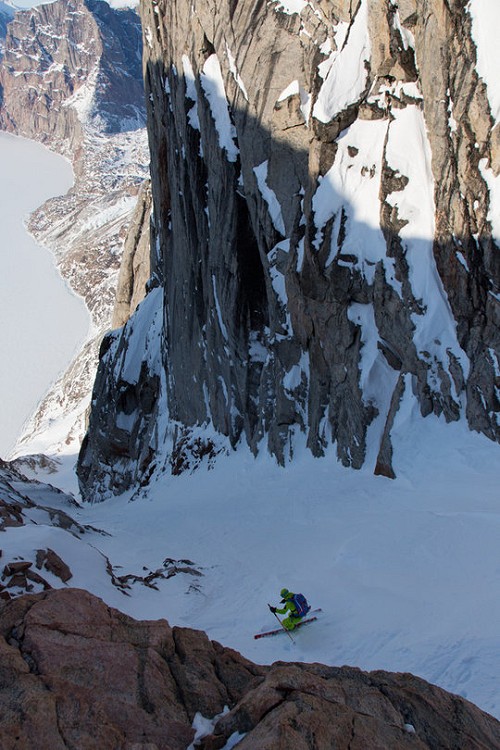
That evening I decided to back up the photos on a laptop and portable hard drive. Even with it insulated in a sleeping bag with a hot water bottle under the hard drive and it took 4 hours to do what would normally take a few minutes as the temperatures plummeted into the minus 30ºC range.
In Gibbs Fjord we followed a daily regime of getting up around 9am when the sun hit camp, have breakfast, then go ski the first line that took our fancy. Each line held unique rock architecture that never failed to inspire as the imagination went wild with all the skiing and climbing possibilities around us.
One day we woke up to low cloud and some fresh snow and decided to skin up fiord as far as possible to explore and look for that ‘big line’. With the cloud base at 600m we passed a buttress more akin to a fairy tale fortress with some of the biggest walls we had seen. The fortress is an incredibly impressive mountain feature, immense acres of impeccable vertical rock soaring upwards with no hint of relief. A couloir split the buttress but looked like it hit a cul-de-sac at 600 m. We continued on and as the weather cleared we found a good line to ski. At the top we enjoyed a five minute sunbathe before putting the layers back on in preparation for descending into the cold locker. The fresh snow had accumulated in the couloir and effortless big turns took us back to the ice in a few minutes. It was 6pm and the 650m line felt like a half day so we decided to go ski the cul-de-sac line at the fortress.
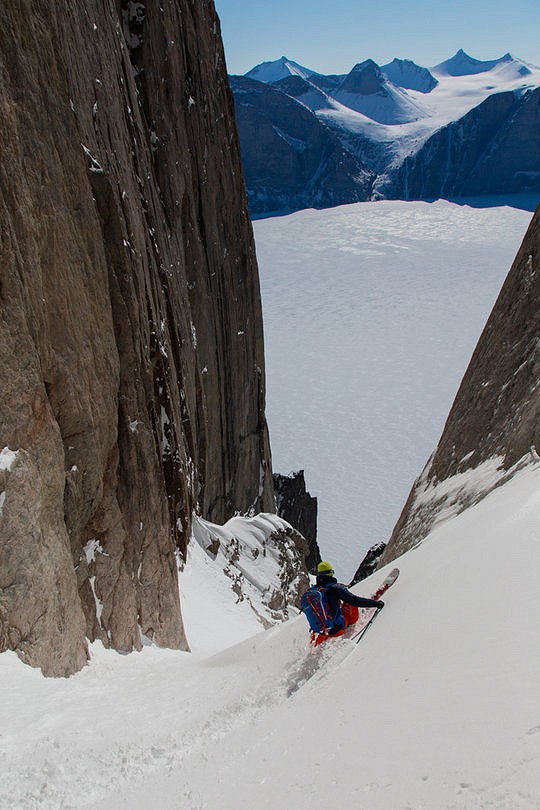
At the bottom I left my thermos with diluted, hot High5 caffeine gels knowing it was going to be a long shift. We were still a way from base camp which was out of sight even on the flat fjord ice. I couldn’t be bothered warming up GPS batteries to find out how far. My mid-layer pockets were stuffed with my camera batteries, lighters, ammunition and my leatherman which I wanted to keep warm to stop it freezing to my fingers. Besides that, opening my outer layers would let that unwelcome cold air in. The climbing was quick and an hour later we find the couloir curves to the right where we thought it stopped. We continued on with little doubt that the couloir will stop round the corner, such is the scale of the walls soaring up around us. I had mixed emotions; I knew Michelle was tired and part of me hoped we find a cul-de-sac, but if the line went to the summit it would be a once in a lifetime opportunity. I slowed down slightly so Michelle didn’t get demotivated and we continued upwards a round another corner. The couloir narrowed from 100 m wide to near 10 m. At 900 m we rounded the next twist on the spiral, the couloir narrowed further down to 3-4 m. I could see light at the end of the tunnel, Oh My God, it goes.
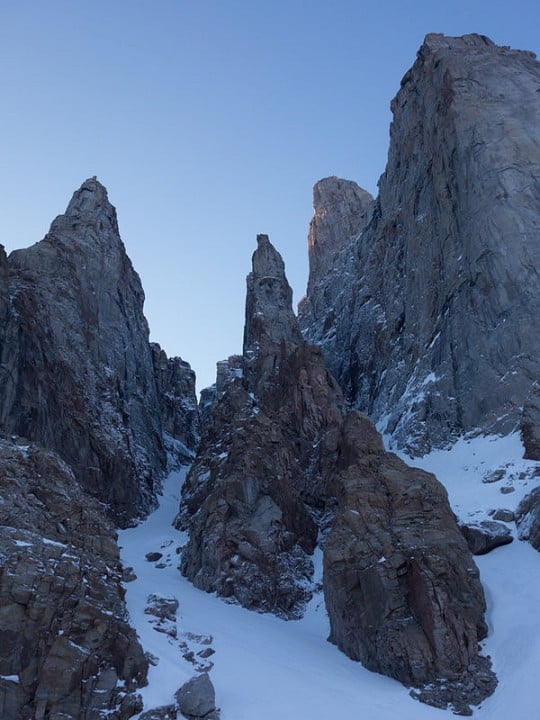
At 11pm we finally topped out on the summit plateau just as the sun dipped below the horizon leaving bright twilight conditions. Marcus and myself briefly discussed waiting for the sun to rise so we could take photos. However, I knew that would be a hard sell to Michelle and definitely a miserable few hours so we quickly put on all our down kit and stepped into our skis. Initially the couloir was 3 m wide and required precision turns but the snow was incredible sluffy powder and even on the steeper rolls the skiing was just unadulterated fun. Occasionally we stopped to film and take some photos but as the couloir opened up at the 600 m point I just wanted get into the flow and sent the remainder of the couloir in one shot with legs on fire and turning to jelly by the bottom. At the ‘shrund’ we all celebrated, stoked with an amazing line that had us in doubt until the last moment, all the sweeter for topping out and knowing that was one of those precious moments in a lifetime.
After sharing the contents of my thermos, we set off back to basecamp with the GPS showing 7 km to go. The rapid temperature drop had created freezing fog on the fjord reducing visibility to 50m. We continued skinning in the murk with tired legs while ice formed on our clothes hair, and eyelashes, distracted from the current unpleasant reality by the memories of what went down in the last few hours. We crashed into basecamp in the early hours, pulled on down trousers and jackets and attacked the snack food while listening to the comforting roar of the stoves from the warmth of our sleeping bags.
It was time for us to move camp again and once more the wind Gods favoured us with wind down Gibbs Fjord and into Refuge harbour. I launched my kite in gusty 40kph with a lot of apprehension and the acceleration was incredible despite towing 2 sleds weighing 100kgs. Almost immediately I spotted one of the steering lines had a twist in it and I had to put the kite down and sort it. This gave me more confidence that I could cope in the wild wind. A few minutes later I was back flying and trucking along happily at 30 kph and making sure the kite stayed clear of the power zone or overhead where it would lift me off the ground. At the junction with the inlet to Refuge Harbour the snow surface was more uneven and the sled with my camera equipment flipped so I had to put the kite down. The wind was stronger now and the kite would not fully depower and continuously kite looped (like a propeller) near the ground as I battled to get it anchored to an ice screw. It took quite some time to sort the lines but the wind was still blowing and I had the choice of covering 10km effortlessly in 20 minutes or burn a lot of calories sled hauling for 3 hours. We finally put the kites down at Refuge Harbour with 20km behind us and ate some lunch in preparation for what lay ahead.
The next few hours promised to be tough sled hauling through the moraines up into Stewart Valley straight into the biting wind. Luck was on our side and a streak of smooth water ice provided easy transportation up into Stewart valley. At some point the pressure of the lake must have washed out a section of moraine providing the channel we followed. At the end of the first lake we made camp on a desolate freeze dried and wind blasted beach, trying to gain some shelter behind a small spur from the incessant wind. In the morning the wind continued to howl and we broke camp quickly knowing there was a long way ahead. For about 10km we hauled over the ice and wind eroded snow bumps that were left over from the autumnal snow falls. The unravelling scenery provided welcome relief from the monotony of sled hauling and I spent my time studying the rock faces, looking for any continuous free climbing features, which were few and far between.
As the incredible Sail Peaks came into view we spotted a couloir that split the main peaks. For the next few hours of hauling we kept looking towards it hoping it would go. Once we got in line of sight we could see that the couloir had its glacial ice teethed bared and it wasn’t to be. With the cold wind, I don’t think any of us were that psyched to break our rhythm and go skiing, preferring instead to stay hauling in hope of finding a sheltered camp. At lunchtime we found a small boulder under Great Sail Peak and dug into the snow accumulation on the lee side to get out the wind while we got the stove going. It was Marcus' birthday and a pretty cool place to spend it. We sat down to eat soup and both of us saw that Michelle’s nose had frozen in the wind. The map showed it was another 15km to the end of the lake that made the ideal stopping point for the day. As the kms dragged on, I found myself burning fuel at an incredible rate of 3 bars an hour. Our food rationing was 4 bars per day.
A couple of kms from the beach we spotted a sheltered recess in the snow-covered moraine. It was so good to be able to fully relax without being harassed by the wind. The site also had a large boulder that provided one of the only civilised toilets we had encountered in the Arctic. Up until then this had been a particularly unpleasant affair, generally involving several things freezing fast. In the morning I cut a seat into a snowdrift and enjoyed my coffee while taking in the view back down Stewart Valley. It was the first seat with back support for ten days and it felt wonderful to let those muscles relax. With what could have been the highlight of my day over, we started sled hauling to the ‘Russian Beach’ at the Southern end of the lake Stewart (so named after a Russian big wall team took two days ferrying loads en route to put up Rubikon on Great Sail Peak). My Achilles had started to play up and I cut away a section of the boot liner to relieve the pressure, hoping this would prevent further aggravation. 5km of moraines separated us from the Walker Arm and we weren’t about to get through ‘Scott free’. A variety of hard snow interspersed with rotten sugar snow over loose rock had us sweating and cursing as we triple carried over the watershed. By evening we had covered 1km of moraine and I was over it. Instead of continuing we decided to reward ourselves and go for a night ski in the worthy Crosshairs Couloir. We raced up the couloir trying to stay in last rays of sunshine as it crept up the mountainside. At the top we soaked up mindblowing views into Stewart Valley and down the rose tinted Walker Arm to the hanging Northwest Passage Couloir. A 1000m trail of creamy powder in Crosshairs was a great end to the day as we skied back to camp in the dreaded moraines.
I woke up to what felt like groundhog day, still in the middle of the moraine nightmare. We double carried up a 50m high spur and dropped down onto a small glacier. After a short section of easy travel we encountered more peppery terrain which caused frustration to build with sleds overturning, sleds overtaking, skins falling off with the cold, and general moraine warfare. Finally we encountered a vein of snow that lead us quickly down the last kilometre to the edge of the Walker Arm and we celebrated the end of the trip difficulties with a another big meal. Back on easy flat sea ice we hauled for a couple of hours across to the Walker Citadel with the sun beaming down the fiord at our latest camp site until 10 pm.
Now we were in the established skiing zone with all the classics it was more relaxed and easier to plan the days according to the time we wanted to ski. Simply knowing the height of the lines accurately gives us a huge advantage in planning our days. Marcus and myself started off by skiing Debris Couloir which is the left branch of the converging couloirs on the North Side of Walker Citadel. The other branch has a large hanging serac barring the way that drops all the ice debris onto the fiord. At the 900 m mark there is 50-75 m of rock barring access to the plateau and we skied from the cul-de-sac. Boot-deep blower pow provided very sensual turns and we skied fast and effortlessly down the first 500 m. Below this the snow turned to firmer chalk but it was still fun flowy skiing.
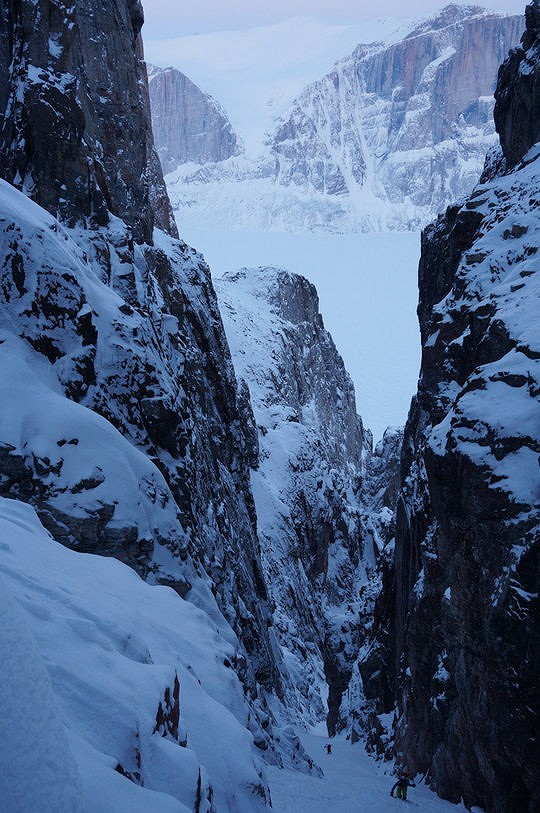
Our base camp was only 200m away and as we rounded a spur we saw that Ilko and John had arrived bringing out our 4th team member Tom. We hadn’t seen a soul for 3 weeks with the exception of 2 birds and a seal, so it was bit surreal having the influx of visitors. Ilko knelt on the ice and set about his lunch which was a frozen Arctic Char that he caught on a previous fishing trip. We all sampled some, relishing the chance to eat real food. The previous 3 days sled hauling and load carrying through the moraines was a turning point for me in terms of weight maintenance and calorie balance. Even though it was getting warmer every day, I had started waking up at 3am slightly cold due to low blood sugar and unable to sleep with hunger pains. Fortunately our diet had been supplemented with High5 sport nutrition that had enabled a massive daily calorie intake. Marcus had previous polar experience and was ahead of us from the start with a disciplined approach to fat intake so I quickly followed suit, adding tablespoons of butter to my hot water and swigging straight from the olive oil bottle, albeit once it was defrosted in a pan of hot water! Another treat was attacking the frozen Nutella with an ice axe. It was just a matter of eating at any opportunity.
Ilko and John headed off to Sam Ford Fjord for an overnight Caribou hunting trip and we decided to spend the afternoon skiing the 600m Broken Dreams couloir that terminates in the notch on the Walker Citadel where the Walker Arm curves round and heads inland. The sun hits this line in the evening and it was our first time skiing in the sun. In the couloir we found that the wind had scoured the new snow but the notch had an amazing view to the line of Northwest Passage which looked insanely steep and hung ominously over the Walker Arm. As we started off down the couloir, the sun set fire to the massive west wall of the Walker Citadel.
The next day Ilko and John returned from their hunting trip empty handed but with tales of a caribou that was too big for them to take on. Michelle was preparing to leave with the hunters and we decided to hop a ride 10km down fiord to Polar Star Couloir on the Beluga Spire – possibly the most hyped couloir in the world. I got a good view as we approached on snow machine and its every bit as stunning in reality as the photos I have looked at over the years.
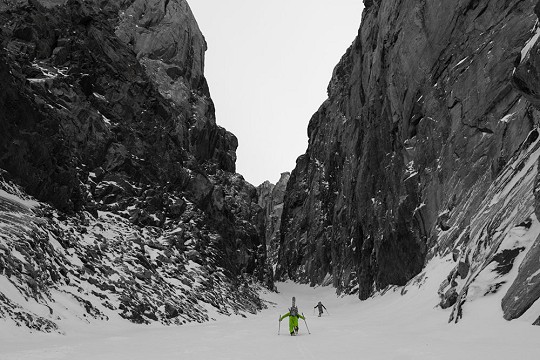
The boot packing went quickly until near the top where we encountered a ribbon of snow with glacial ice either side. We continued up but the snow depth thinned to 3 inches over death ice, good enough for one skier to pass but not the 3 of us. We downclimbed a little until 10 inches of snow allowed us to transition to our skis. Without harnesses or ice screws there was no way to secure yourself and it was down to a balancing act. Even then my upper edge sat on the boiler plate ice and it was good to get going after the nervy transitional stress position. The snow below was powdery and some special turns with the odd face shot took us down fast. All to quickly we had skied what Andrew McLean dubbed the ‘best couloir in the world’.
That evening an Arctic fox came to visit our base camp and snaffled up some morsels where Ilko had been eating his Arctic Char. Normally foxes follow the bears and eat the leftovers and with this reminder we increased our vigilance.
The next day we hit a 1450m South facing line we had been spying for a couple of days. I woke up feeling nauseous with stomach cramps, suspecting the dehydrated meals had sucked too much water out of my guts. We skated over the fiord at sunrise and quickly discovered that the south faces were roasting. It’s the first day without neoprene overboots and unused to the heat I stripped down to my base layers. Sweat was pouring down my face into my eyes. After being in the freezer for weeks it was a strange sensation to be overheating. I put my water bottle onto the waist strap of my pack so I could drink regularly but near the top I took off my rucksac and forgot about my water bottle, which proceeded to slide 1400 m to the fiord. As I topped out all I could think of was drinking litres of water and sleeping so I left the guys to hang out in the sun and started down the line. The velvet corn snow provided smooth silky skiing and 5 minutes later I’m at the fiord. I picked up my water bottle and drained it, then proceeded to down the contents of my thermos. Back at camp I slept for the rest of the afternoon.
Our sights now moved back to the Walker Citadel and a South facing line that Marcus had previously discovered. It seemed so unlikely that any continuous line of snow could penetrate this rock bastion. We skated 5kms around the East face and another 1450m torture session landed us on the summit plateau. Not many people have stood there and we enjoyed the evening light from this commanding position with stunning 360° views while eating rehydrated humus and bagels. Sitting with our legs dangling over the edge of these 1450m big walls was a trip in itself. We eventually tore ourselves away from this special place and reluctantly stripped off some layers for the skiing. The line started off with some technical turns on wind sculpted snow before deepening into a enormous amphitheatre with views to the Stump Spire. While we skied Marcus took photos from the plateau. We regrouped 500 m from the bottom and I started to ski out the line as fast as I could when a fist sized rock came over my head missing me by 30 cm. The guys had been screaming warnings once they saw it ricochet off the wall towards me but the noise of my edges on the firm snow masked their cries. With the classic line called ‘Broken Dreams’ on one side of the Citadel, an apt name for the line might be ‘Wet Dreams’, although Marcus had coined it ‘Citadel’s Secret’. We know of no other ski descents of this line.
That night we were visited by a couple of Inuits who were en route to hunt and came to let us know they had seen a polar bear a few kms down fiord. We had seen bear tracks throughout the trip, often a mother with one or two cubs but we had never seen our potential hunters. For the next hour Marcus grid searched the area with his high powered rifle scope while I made sure my weapon and rounds were good to go.
Next up on our list was the 1200 m Northwest Passage that was a 10 km skate up fiord. The meaty upper pitches of the line hang over the Walker Arm and it sits hemmed in underneath a huge wall. After another torturous bootpack session we hung out on the plateau soaking up the warmth like lizards and entertaining ourselves with some extreme boulder trundling, trying to get something all the way to the fiord. Once again we were lucky with fantastic boot deep powder in the couloir which took the edge off the 50 degree turns. Lower down the line we hit the evening sun and it was possible to open up the turns and freeride down to the fiord. We all agreed about the quality of the skiing and situations of this line over another big meal at base camp.
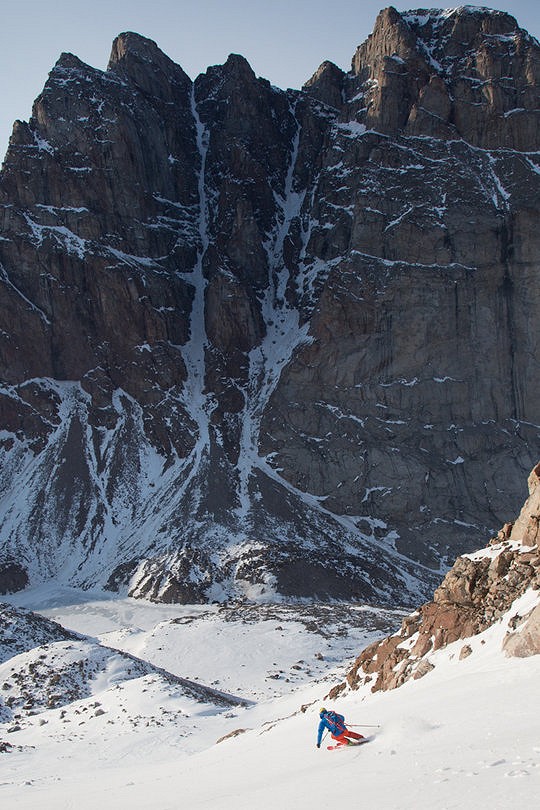
Our options from our current base camp were now limited so the next day we moved out and hauled to the bay on the NE corner of the Walker Citadel. Leaving our kit there we went to the NW Couloir right of the Stump Spire. From the summit of the Citadel we had looked down on this couloir and guessed it topped out at 1000 m. Initially the line took a ribbon of snow underneath a sea of slabs, helpfully avoiding any further undesirable moraine warfare. We earned 100m of bonus turns finding the col to be 1100 m with superb situations opposite Citadel’s Secret and the vast East Face.
The lower half of the run was bathed in milky evening sunshine and we paused for a moment taking it all in before following the ribbon back to the ice. After skating back to our sleds and consuming another big meal, we psyched up for the sled hauling to Sam Ford Fiord by drinking our remaining freeze dried coffee, eventually setting off about 9 pm and being treated to moonrise between the Beluga Spire and the Polar Sun Spire. Here we encountered a lead in the ice running the width of the fiord, the first sign of breakup and a reminder that the trip was coming to an end. At midnight we were under the cross on Great Cross Peak, a natural mark that has served as a landmark to the Inuit for generations. Some fresh bear tracks put us off camping there. We brewed up and ate some snacks before continuing onwards across Sam Ford Fiord in order to get a camp location in the sun that served both sides of the fiord. The polar frost had descended and it was cold and damp but by 2 am the frost had lifted and the temperature had risen slightly even though sunrise was still a couple of hours away. At 3 am I crawled into my bed glad to be lying down and quickly passed out after our longest day yet.
This was our 7th and final base camp of the expedition that thankfully put an end to any sled hauling. Over the remaining days we skied 6 classic routes on Sam Ford Wall and one 450 m ramp situated between AC Cobra and Pinto which provided access to a large ledge system with fantastic views and quality skiing down the couloir. It is hard to know if that was another first descent, the shortness of the line perhaps meant it had been previously overlooked, but it provided fine late afternoon entertainment. One afternoon found us hanging out on top of one of the big walls on Ford Wall entertaining ourselves trundling rocks. The fall line took rocks straight into the gully system that acted as a natural amplifier as our rock exploded on impact, 9.5 seconds later. We would burst into fits of giggles and do it again and again.
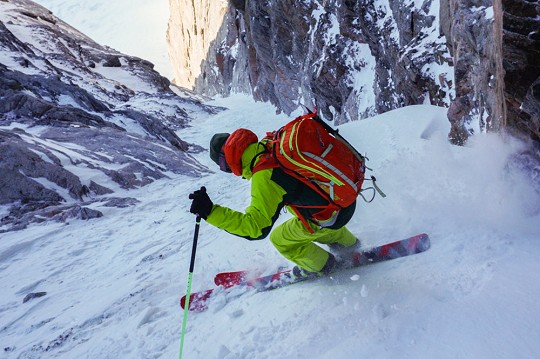
The team also repeated Inquisition on Great Cross Peak and kited down to the 1500 m buttress to the North of Great Cross and skied a fantastic spiralling east facing line that hit a step at 1000 m. Near the bottom of the couloir we found a table top rock perch and sat and shared the last of our day food. The added bonus was finding the wind was now up fiord which enabled us to kite home at 30 mph saving us 750 very precious calories.
With 20220 m of climbing and skiing behind us, our rationed meals dwindling fast and signs of the ice break up starting, we made the call to our Inuit friends to come pick us up. Late the following afternoon Ilko appeared with his other son Michael. We packed up our tents quickly knowing it would be a really long day for our drivers by the time they got back to Clyde by the early hours. A few kms down fiord we started to encounter leads in the ice that the snow machine couldn’t cross. On one occasion we pushed a floe towards the upper fiord ice, drove the machine onto the floe, then pushed it towards the lower fiord ice and drove the machine off. On another occasion the Inuit demonstrated their ice craft by chiselling away blocks of ice with a steel spike to allow the machine to pass onto the ice attached to the walls and get round the lead. The komatiks were long enough to manually push across the leads. The final stretches across the land were now often bare rock and heather. As we crested the col into Ellington Fiord, one of the snow machines flipped and we rushed to right the machine and free the driver who we found laughing at the incident. The downhill from the col saw the heavier komatik trying to over take and jack knife the snow machine and we all stood at the back of the komatic ready to jump off should it all go wrong. Our driver had no choice to gun it and it was terrifying knowing a large bump could be lurking anywhere in the flat light. After crossing Elington Fiord we arrived at the half way hunter’s hut for a welcome break from the bone rattling ride. Here we met a hunter with his dog train who had spent 8 days travelling down from Pond Inlet to Clyde River solo. A few hours later we slid into Clyde River and quickly offloaded the komatiks at our shack on the beach where the adventure had started a 35 days before. Marcus and myself had spent a total of 30 days on the ice. Our Inuit friends were eager to get to their beds after 16 hours of driving but were back early the next morning for a farewell coffee and bacon rolls.
This marked the end of the an all time ski trip for me which wouldn’t have been possible without the help of all the sponsors and people who contributed to the success of the trip and who I can’t thank enough. The leads in the ice experienced on the journey out from Sam Ford Fiord meant we couldn’t have stayed any later than the 3rd week of May and it was a solid reminder that the climate is changing quickly. A decade ago travel by snow machine would have still been possible a month later towards the end of June.
Ross' trip was sponsored and supported by:
Berghaus, Black Crows, Scarpa, Grivel, Mountain Boot Company, Lyon Equipment, PLUM, High 5 and many others too numerous to mention here.
The team consisted of: Ross Hewitt, Tom Grant, Michelle Blaydon and Marcus Waring.
Watch a video of the trip below:
- Skiing The Alpine Trilogy Project 13 Nov, 2015









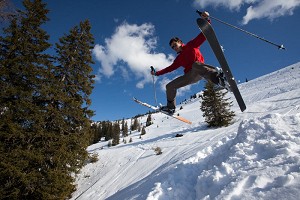
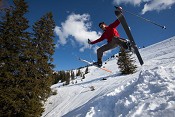








Comments